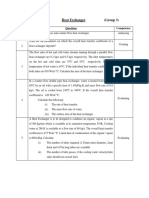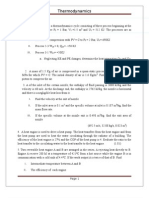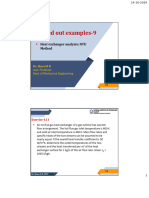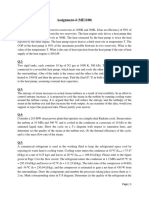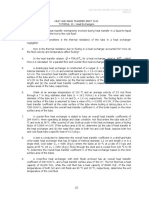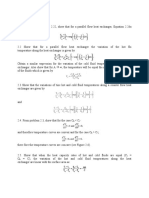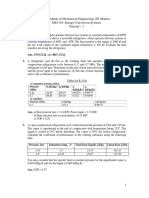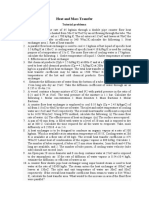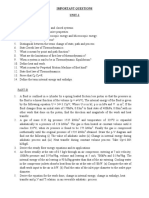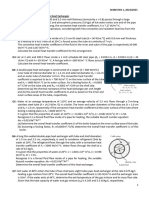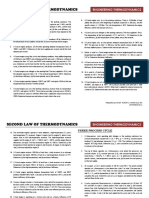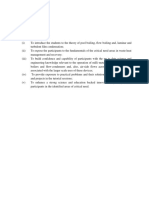Heat Exchanger (Group 2) : Sl. No Questions Competence
Heat Exchanger (Group 2) : Sl. No Questions Competence
Uploaded by
rajibaecCopyright:
Available Formats
Heat Exchanger (Group 2) : Sl. No Questions Competence
Heat Exchanger (Group 2) : Sl. No Questions Competence
Uploaded by
rajibaecOriginal Description:
Original Title
Copyright
Available Formats
Share this document
Did you find this document useful?
Is this content inappropriate?
Copyright:
Available Formats
Heat Exchanger (Group 2) : Sl. No Questions Competence
Heat Exchanger (Group 2) : Sl. No Questions Competence
Uploaded by
rajibaecCopyright:
Available Formats
Heat Exchanger (Group 2)
Sl. No Questions Competence
1 Define effectiveness of a heat exchanger. Write the equation of effectiveness Remembering
in case of parallel flow heat exchanger and counter flow heat exchanger.
2 What do you mean by NTU method Understanding
The flow rates of hot and cold water streams running through a parallel flow
heat exchanger are 0.2 kg/s and 0.5 kg/s respectively. The inlet temperatures
3 on the hot and cold sides are 750C and 250C respectively. The exit
Evaluating
temperature of hot water is 450C. If the individual heat transfer coefficient on
both sides are 650 W/m2 0C. Calculate the area of the heat exchanger.
A counter-flow heat exchanger is employed to cool 0.55 kg/s
(cp = 2.45 kJ/kg 0C) of oil from 1150C to 400C by the use of water. The inlet
and outlet temperatures of cooling water are 150C and 750C respectively. The
overall heat transfer coefficient is expected to be 1450 W/m2 0C. Using NTU
4 method, Calculate: Evaluating
(i) mass flow rate of cooling water,
(ii) the effectiveness of heat exchanger.
(iii) The surface area required
The following data relate to a parallel flow heat exchanger in which air is
heated by hot exhaust gases
Heat transferred per hour = 155450 kJ
Inside heat transfer coefficient = 120 W/m2 0C
Outside heat transfer coefficient = 195 W/m2 0C
5 Inlet and outlet temperature of hot fluid is 4500C and 2500C respectively Evaluating
Inlet and outlet temperature of cold fluid is 4500C and 2500C respectively
Inside and outside diameter of the tube is 50mm and 60mm respectively
Calculate the length of the tube required for necessary heat transfer to occur.
Neglect the tube resistance
You might also like
- Lecture 3-1 - Heat Exchanger CalculationsDocument50 pagesLecture 3-1 - Heat Exchanger CalculationsBilal AhmedNo ratings yet
- Heat Exchanger (Group 1) : Sl. No QuestionsDocument1 pageHeat Exchanger (Group 1) : Sl. No QuestionsrajibaecNo ratings yet
- Group 3Document1 pageGroup 3rajibaecNo ratings yet
- Question Bank On Unit 6Document5 pagesQuestion Bank On Unit 6dongaNo ratings yet
- 515MET02 HMT Unit 3 FinalDocument4 pages515MET02 HMT Unit 3 Finalntamilselvan.eecNo ratings yet
- Heat ExchangerDocument1 pageHeat ExchangerArpit GoyalNo ratings yet
- Home Assignment - 2: Mechanical Engineering Department Asansol Engineering College, AsansolDocument1 pageHome Assignment - 2: Mechanical Engineering Department Asansol Engineering College, AsansolMd SohailNo ratings yet
- Thermodynamics Question Set ADocument4 pagesThermodynamics Question Set AVivek Negi100% (1)
- Worked Examples With Solutions - 9Document4 pagesWorked Examples With Solutions - 9laudyavathbhanuNo ratings yet
- Assignment-4 ModDocument2 pagesAssignment-4 ModSai naveenNo ratings yet
- Heat Exchanger NumericalsDocument1 pageHeat Exchanger NumericalskaushikNo ratings yet
- Faculty of Engineering Department of Mechanical and Marine Engineering Thermodynamics (TDN620S)Document4 pagesFaculty of Engineering Department of Mechanical and Marine Engineering Thermodynamics (TDN620S)Wilbard IitulaNo ratings yet
- Practice Problems For Heat ExchangerDocument2 pagesPractice Problems For Heat ExchangerFour AyesNo ratings yet
- Tutorial 3 SolutionDocument5 pagesTutorial 3 Solutionngoc.nguyennhuNo ratings yet
- Assignment 5Document2 pagesAssignment 5pradeep.kumarNo ratings yet
- Solved Problems - Heat Exchangers UNIT-4Document13 pagesSolved Problems - Heat Exchangers UNIT-4doddi.ajith2003No ratings yet
- Parallel Flow, A (m2) 2.624 Counter Flow, A (m2) 2.434 Shell and Tube HX, A (m2) 2.523Document4 pagesParallel Flow, A (m2) 2.624 Counter Flow, A (m2) 2.434 Shell and Tube HX, A (m2) 2.523Chinwuba Samuel EbukaNo ratings yet
- Tutorial 10 CengelDocument1 pageTutorial 10 Cengelsakinah azizanNo ratings yet
- Basic Design MethodologyDocument4 pagesBasic Design MethodologySatya SuryaNo ratings yet
- HT Assignment U-4Document1 pageHT Assignment U-4ajayteja1080No ratings yet
- Thermodynamics II Assignment 3: C R I H H I R H HDocument2 pagesThermodynamics II Assignment 3: C R I H H I R H HPriyanshuNo ratings yet
- Assignment 2Document2 pagesAssignment 2Lovish ChopraNo ratings yet
- Assignment - IVDocument4 pagesAssignment - IVdivyanshu.221ch018No ratings yet
- Evaluacion 2 Transferencia 202010 Taller Intercambiadore CalorDocument1 pageEvaluacion 2 Transferencia 202010 Taller Intercambiadore CaloryiuseppeNo ratings yet
- 2022 Practical Guide-Shell and Tube Heat ExchangerDocument9 pages2022 Practical Guide-Shell and Tube Heat ExchangerBabalo MapindaNo ratings yet
- Visvesvaraya National Institute of TechnologyDocument5 pagesVisvesvaraya National Institute of TechnologyAbhishekRajeshDhobeNo ratings yet
- ME214 BTD Tutorial QuestionsDocument2 pagesME214 BTD Tutorial QuestionsKONDALRAONo ratings yet
- Tutorial 3Document1 pageTutorial 3B V V HANUMA GAYATHRINo ratings yet
- Heat Transfer Tutorial 2Document2 pagesHeat Transfer Tutorial 2vicopipNo ratings yet
- Department of Mechanical Engineering, IIT Madras ME3103: Energy Conversion Systems Tutorial - 1Document3 pagesDepartment of Mechanical Engineering, IIT Madras ME3103: Energy Conversion Systems Tutorial - 1Harsh GuptaNo ratings yet
- Tut 4 Heat ExchangersDocument2 pagesTut 4 Heat ExchangersGomolemo BaarxxNo ratings yet
- HMT Tutorial 2Document1 pageHMT Tutorial 2Prachi DasNo ratings yet
- A3 - Tutorial Problems - Heat Exchangers Feb 2024Document12 pagesA3 - Tutorial Problems - Heat Exchangers Feb 2024RAPELANG MORAPEDINo ratings yet
- Tutorial 7 Heat ExchangersDocument2 pagesTutorial 7 Heat ExchangersLoago IshokoNo ratings yet
- Design of HEDocument35 pagesDesign of HESaurabh SengarNo ratings yet
- Tutorial Questions On Heat Ex ChangersDocument3 pagesTutorial Questions On Heat Ex ChangersPuneet Garg100% (1)
- Important QuestionsDocument5 pagesImportant Questionstamilselvan nNo ratings yet
- Assignment 04Document4 pagesAssignment 04abhinavkumar3607No ratings yet
- Manual Shell and Tube Heat Exchanger 9Document6 pagesManual Shell and Tube Heat Exchanger 9aashuNo ratings yet
- Assignment 3Document3 pagesAssignment 3happy20212025No ratings yet
- Concentric Tube Exchanger (LAB MANUAL)Document18 pagesConcentric Tube Exchanger (LAB MANUAL)Atif MehfoozNo ratings yet
- BT Quiz - 2Document8 pagesBT Quiz - 2Navdha KapoorNo ratings yet
- Assaingment Rac 1Document6 pagesAssaingment Rac 1Hariom MouryaNo ratings yet
- Tutorial 6_SolutionDocument8 pagesTutorial 6_SolutionTHƯ LÃ NGUYỄN ANHNo ratings yet
- Modal QuestionDocument9 pagesModal QuestionAnuj KumarNo ratings yet
- Tutorial 1 - QuestionsDocument5 pagesTutorial 1 - Questions2200851No ratings yet
- Numerical Problems LMTDDocument4 pagesNumerical Problems LMTDKhalidNo ratings yet
- Double Pipe Heat ExchangerDocument8 pagesDouble Pipe Heat ExchangerElias BiramoNo ratings yet
- 10 Numerical 10Document1 page10 Numerical 10Aakash AgarwalNo ratings yet
- PS CarnotDocument2 pagesPS CarnotBien BasbasNo ratings yet
- 1 Effectiveness of Parallel Flow Heat ExchangerDocument6 pages1 Effectiveness of Parallel Flow Heat Exchangermurugan.bala816776No ratings yet
- Unit-3 HMTDocument1 pageUnit-3 HMTArunkumar MunimathanNo ratings yet
- Sheet #7Document4 pagesSheet #7Iam A gnoomNo ratings yet
- Assignment Cum Class Test 1 Module 1Document2 pagesAssignment Cum Class Test 1 Module 1yogendra kumarNo ratings yet
- Double Pipe Heat ExchangerDocument3 pagesDouble Pipe Heat ExchangerSayyeda Neha FatimaNo ratings yet
- ECE 2104 Tutorial 3Document1 pageECE 2104 Tutorial 3n02220186jNo ratings yet
- Practical GuideDocument10 pagesPractical GuideDamaris ThamiNo ratings yet
- Module 4 ObjectiveDocument1 pageModule 4 ObjectiverajibaecNo ratings yet
- Explain The Term "Hydrodynamic" Lubricated BearingDocument1 pageExplain The Term "Hydrodynamic" Lubricated BearingrajibaecNo ratings yet
- ShaftDocument3 pagesShaftrajibaecNo ratings yet
- Latest News For Competitive Exams: Ques 2Document2 pagesLatest News For Competitive Exams: Ques 2rajibaecNo ratings yet



